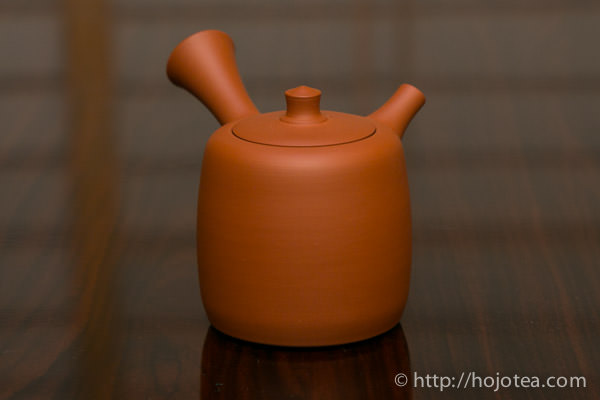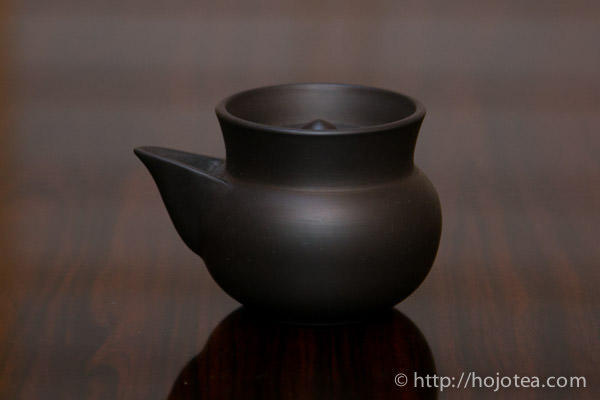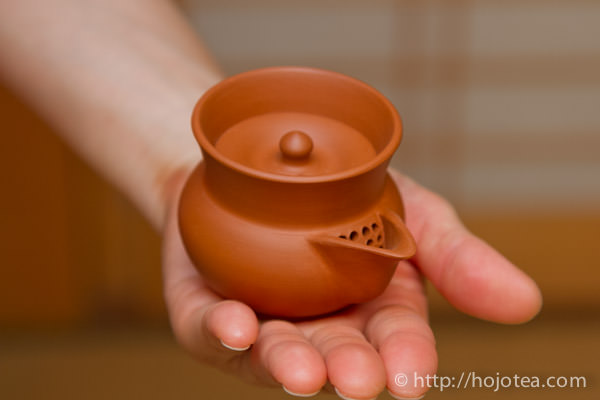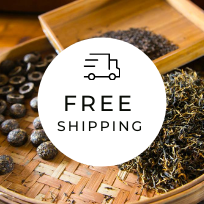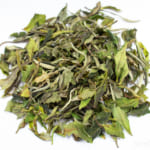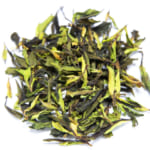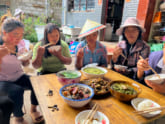- HOME >
- Featured Articles
Selecting Suitable Clay for Japanese Green Tea
- [2014.10.02] Posted By Akira Hojo
I would like to explain the points on how to choose the right type of clay teapot for a Japanese green tea.
The taste alteration by various clay teapots
The taste of tea will noticeably change depending on the type of clay we use. The outcome in the taste alteration using a clay teapot is not of many different ways in fact. The taste differs thanks to the clay used for the teapot and the existing minerals in the clay. Basically, there are two kinds of changes in taste in responding to the clay.
- Increase or decrease in Body
- Increase or decrease in After Taste
The body refers to the width, richness or the full spreading sensation in our mouth. If the body of the same tea is enhanced, you will feel that the tea flavour becomes stronger. However, it is not only the desirable flavour that is increased, but the less attractive flavour also enhanced when the body is enhanced. On the other hand, the after taste means the lingering taste/flavour, the transparency and the depth of taste. The body is the horizontal sensation while the after taste is the vertical sensation. If tea has both body and aftertaste in an equal extent of intensity originally, or, enhanced by using a clay teapot, we may feel that the taste and flavour of the tea is three dimensional, rounded; this will be a very nice cup of tea from a subjective point of view.
Selection of suitable clay based on two different types of Japanese green tea
When selecting a clay for Japanese green tea, it depends on the type of Japanese green tea that you intended to brew. In the view of selecting the clay, we can classify the Japanese tea in the following two groups.
- The majority of Japanese green tea: rich in amino acid that gives strong Umami taste
- Bio-Dynamic/Natural farming tea such as Zairai tea: rich in poly phenols and minerals that gives body and after taste.
Japanese tea that is rich in amino acid and gives a strong umami taste
In Japanese tea industry, there is a norm yet odd practice, where they would intensify the amino acid content and the umami taste in tea. Hence, the farmers would try very hard to produce a tea that could meet this criterion. Hence, the application of nitrogen fertilizer by the farmers is to increase the amino acid content in tea. Once nitrogen is applied, the tea trees would grow faster; in order to produce necessary carbohydrates, the tea leaves will increase the number of chlorophyll and speed up the photosynthesis. Thereafter, the appearance of the tea leaves is a very important element to determine the tea quality. Thus, during the production of Japanese green tea, majority of tea manufacturers try their best to remove the stems from tea. As a result, the tea will give the following characters.
- Less after taste
- Less body
- Strong umami taste or saltiness due to high theanine (amino acid) content.
- The distinctive sweet flavour caused by the amino acid when it is baked
- Seaweed flavour
Tea trees grow faster when fertilizers are applied. As a result, tea contains fewer minerals, such as iron, and its taste becomes flat and lacks aftertaste. As for the body of tea, it has something to do with the stem. Once the stems are removed, the tea would give a very light body. It is related to the calcium distribution that may only be accumulated in the stems of the tea and not circulated to the tea leaves.

Therefore, nitrogen fertilizer accumulation will end up in the tea leaves. During the final process of Japanese tea, the crude tea leaves are fired in order to bring up the flavour. If tea contains high amino acid content, it would produce a very distinctive sweet aroma. This aroma is generated due to the oxidation of amino acid and sugar – the Maillard reaction. The mechanism of this reaction is very similar to the way a hot cake produces its sweet aroma when it is baked. Besides, the distinctive flavour produced from the amino acid will also develop a flavour like seaweed when the tea is produced follows the modern agricultural practice which uses fertilizers.
The majority of Japanese green tea available in Japan falls into the category mentioned above. Sometimes as you pay more, you will get the tea with stronger amino acid taste. For this type of tea, generally people would prefer a teapot that increases the after taste and decreases the body. If the clay increases the body, the distinctive oxidized amino acid flavour and the seaweed flavour will be very strong. Actually, not everyone enjoys these flavours. Hence, if a clay decreases the body, it reduces these flavours and increases the aftertaste. As a result, the flavour is more natural, similar to the flavour of fresh natural tea leaves; plus, it also increases the transparency and clarity of taste thanks to the enhancement of the aftertaste. If you brew a Gyokuro in the reduction clay, the seaweed flavour is cut down and its flavour turns out to be very elegant. I suggest the following clays that will reduce the body and increases the aftertaste.
- Nosaka Oxidation Fired clay
- Nosaka Reduction Fired clay
- Banko purple clay
The Nosaka oxidation fired clay gives a stronger body as compared to the Nosaka reduction fired clay. If you wish to drastically reduce the seaweed flavour, I would suggest the Nosaka reduction clay. However, if you wish to maintain a slight seaweed flavour, the Nosaka oxidation clay will be preferable.
Japanese green tea grown Naturally/Bio-Dynamically
For Natural/Bio-Dynamic farming tea or organic farming tea, the nitrogen fertilizer is seldom or occasionally used. As a result, the growing speed of the tea trees is very slow. At the same time, the colour of the tea leaves would be yellow as they do not have to grow fast and does not necessarily need to conduct photosynthesis to produce carbohydrates. These kind of teas contain higher minerals and polyphenol as compare to those that grow faster. Thus, it has a floral flavour that reminds us of Taiwan high mountain oolong. These teas do not give the distinctive oxidized amino acid and seaweed flavour. For this type of tea, I’d suggest a clay that increases both the intensity of body and flavour. If you successfully increase the body of tea, you will enjoy a very rich floral flavour on your palate. For increasing the body of tea, I would suggest the following clays.
- Mumyoi Oxidation Clay
- Kobiwako Clay
- Shigaraki Clay
- Gisui Tokoname Natural Red Clay
The above theory is merely my recommendation. After all, you may need to understand which tea characters you are seeking for the most. If you enjoy an increase of the seaweed flavour or the distinctive amino acid flavour, you may use a clay that increases the body, even for the common Japanese green teas. If you use a reduction Sado clay for the natural/Bio-Dynamic farmed tea, it will minimize the flavour but drastically increases the aftertaste; the tea may be a little weak in character, but it has a very transparent and clear drinking feeling. However, if you are not very sure about your preference, I would suggest a clay that gives an intermediate effect in body such as the Shigaraki or Nosaka oxidation clay.
Related Articles
How to get the latest update on HOJO Tea?
1. Follow Twitter, 2. Click "Like" on Facebook, and 3. Subscribe in newsletter. You can have the latest tea news from HOJO Tea.
 Subscribe the Newsletter to enjoy the privileges
Subscribe the Newsletter to enjoy the privileges- You may receive a free sample upon purchase, or you may have the priority to purchase special products. So please remember to subscribe our newsletter as well as the social network.
- Yunnan Chun Jian Green Tea from High Mountain Gardens
- Yunnan Chun Jian Green Tea is now available.This tea is made from naturally grown leaves harvested from high mountain gardens at 2100m above sea level. It has a rich, long-lasting lingering aftertaste, comparable to raw Pu-erh tea. Yunnan as a Distinctive Tea Growing Region Over the past 20 years, we have explored a wide range …
- Limited Loose Leaf Release of 2025 Da Xue Shan Wild Raw Pu-erh Tea
- We have released the 2025 loose-leaf version of Da Xue Shan Wild Raw Pu-erh Tea.This tea comes from wild tea trees that grow naturally in the high mountains of Yunnan Province, at elevations above 2000 meters. This year, we were only able to secure a small quantity for retail, and the current release is available …
NEW ARTICLES
 Yunnan Chun Jian Green Tea from High Mountain Gardens
Yunnan Chun Jian Green Tea from High Mountain Gardens- Yunnan Chun Jian Green Tea is now available.This tea is made from naturally grown leaves harvested from high mountain gardens at 2100m above sea level. It has a rich, long-lasting lingering aftertaste, comparable to raw Pu-erh tea. Yunnan as a Distinctive Tea Growing Region Over the past 20 years, we have explored a wide range …
 Limited Loose Leaf Release of 2025 Da Xue Shan Wild Raw Pu-erh Tea
Limited Loose Leaf Release of 2025 Da Xue Shan Wild Raw Pu-erh Tea- We have released the 2025 loose-leaf version of Da Xue Shan Wild Raw Pu-erh Tea.This tea comes from wild tea trees that grow naturally in the high mountains of Yunnan Province, at elevations above 2000 meters. This year, we were only able to secure a small quantity for retail, and the current release is available …
 2025 Da Xue Shan Wild White Tea Now Available from Yunnan
2025 Da Xue Shan Wild White Tea Now Available from Yunnan- The 2025 harvest of Da Xue Shan Wild White Tea is now available. Crafted from truly wild Camellia taliensis trees growing naturally in the high-altitude forests of Yunnan, this tea offers a purity and character unique to its origin. This year’s unusually dry climate during the withering season was ideal, resulting in a floral and …
 Why Do Some Teas Taste Astringent? Exploring the Causes and Mechanisms of Astringency
Why Do Some Teas Taste Astringent? Exploring the Causes and Mechanisms of Astringency- Tea can range from having no noticeable astringency to possessing a very strong one. What causes this astringency? This article explores the causes and mechanisms behind astringency in tea. Causes of Astringency Astringency arises from the binding of tea components to proteins in the oral cavity, creating a sensation of tightness or dryness. The tongue …
 The Impact of Heat Sources on Tea Flavor
The Impact of Heat Sources on Tea Flavor- It is widely recognized that the material of a kettle plays an important role in shaping the taste of water for brewing tea. Yet, an often overlooked but equally significant factor is the type of heat source used to boil the water. Different heat sources, whether gas, electric, charcoal, or wood fire, can impart distinct …
 New Release of High Mountain White Tea
New Release of High Mountain White Tea- We are pleased to introduce our High Mountain White Tea, sourced from a unique tea garden with two key features: 1. Located at an altitude of 2200-2300m2. Completely wild and untended The ideal natural conditions of this garden result in tea of exceptional quality, offering a pure and gentle, nourishing taste. High Altitude and Wild …
 New Release of Da Xue Shan Wild White Tea 2024
New Release of Da Xue Shan Wild White Tea 2024- We have released the 2024 Da Xue Shan Wild White Tea Loose Leaf. This tea was produced under our direct supervision during our stay in Yunnan Province, ensuring meticulous production management on site. Definition of Wild Tea in Yunnan Province People in Yunnan strongly associate Camellia taliensis with wild tea, regardless of where it is …
 New Release of Wild Pu-erh Jasmine Pearl
New Release of Wild Pu-erh Jasmine Pearl- Out of curiosity, we decided to create a jasmine tea based on Da Xue Shan Wild Raw Tea. This resulted in an exceptionally rare tea, not only in Japan but also in China. Custom Production Network for Jasmine Tea At our store, we source various types of base teas from different regions during the spring. …
 2024 Overview: Our Yunnan White Tea Quality, Process, and Weather Insights
2024 Overview: Our Yunnan White Tea Quality, Process, and Weather Insights- One of the teas we’ve been focusing on in Yunnan Province is white tea. Historically white tea has been produced in both Fujian Province and Yunnan Province for a long time. While white tea from Fujian Province is well-managed during processing, we are dissatisfied with the quality of the raw materials due to the use …
 Yunnan’s Hospitality Culture: Expressed Through Meals
Yunnan’s Hospitality Culture: Expressed Through Meals- In China, as a form of greeting, it’s common to say “你吃饭了吗?” which means “Have you eaten?” However, in Yunnan Province, the phrase “吃饭” is often used in various situations, more like “Eat, eat,” serving as an invitation to share a meal. Yet, with prolonged exposure to Yunnan, one comes to understand that these meal …
Shop Info

Address:Lot No. T-215, 3rd Floor, The Gardens Mall, Mid Valley City, Lingkaran Syed Putra, 59200 Kuala Lumpur
Tel: +603-2287-4537
Business Hour: 10am to 10pm
Category
- New Arrival at HOJO Online Shop
- Featured Articles
- Newsletter
- Types of Tea
- Origin of Tea
- Teapot and Tea Equipment
- Tea Column
- How to enjoy tea
- Tea Processing
- How to choose quality tea
- Tea constituents and functional effect
- Safety of Tea
- Foods
- Tea Business Operation
- Hobby and Outdoor Activity
- Ranking of Tea
- Video
- FAQ
- Media Release
Profile

- AKIRA HOJO
- I invite you to experience my tea selections.I was born in Nagano, Japan. In university, I studied agricultural chemistry, and I have the master degree in food science. I worked in Japanese food industry for 10 years. I involved in R&D, QC and QA. As a factory manager, I implemented ISO9000 series and managed the factory.
- The Art of Tea Magazine
- We posted the article on “The Art of Tea Magazine No.9, the magazine is published in Taiwan. We featured some scientific view about the tetsubin
- New Straits Times
- The Malaysian National Newspaper, New Straits Times featured HOJO Tea on 17-Oct-2007.

